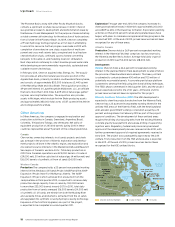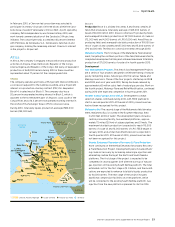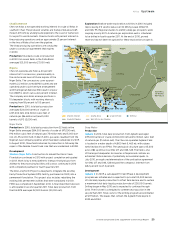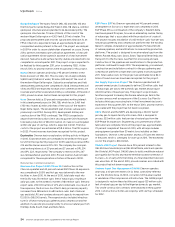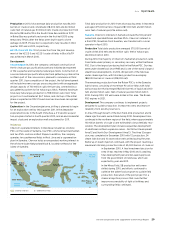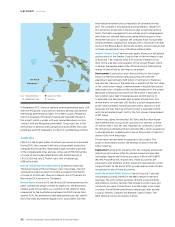Chevron 2010 Annual Report Download - page 28
Download and view the complete annual report
Please find page 28 of the 2010 Chevron annual report below. You can navigate through the pages in the report by either clicking on the pages listed below, or by using the keyword search tool below to find specific information within the annual report.
26 Chevron Corporation 2010 Supplement to the Annual Report
Tengiz and Korolev TCO is operating and developing the Tengiz
and Korolev crude oil fields in western Kazakhstan under a
concession that expires in 2033.
Production Total daily production in 2010 averaged 567,000
barrels of crude oil (234,000 net), 822 million cubic feet of natural
gas (338 million net) and 44,000 barrels of NGLs (18,000 net).
In 2010, TCO continued to increase production from the Sour Gas
Injection (SGI) and Second Generation Plant (SGP) facilities.
During 2010, the majority of TCO’s crude oil production was
exported through the Caspian Pipeline Consortium (CPC) pipeline.
The balance of production was moved by rail to Black Sea ports
or to Aktau, Kazakhstan, and then via tanker to Baku, Azerbaijan,
also for shipment by rail to Black Sea ports.
Development The Sulfur Expansion Project is expected to increase
TCO’s sulfur-granulation capacity and eliminate routine addition
of sulfur inventory at the storage pads. The project is scheduled
to start up in 2012.
TCO continues to evaluate options for an expansion project similar
in scale to the SGI/SGP Project. The Future Growth Project will
utilize sour gas injection technology developed for SGI/SGP and
is expected to increase total daily crude oil production by 250,000
to 300,000 barrels. FEED is scheduled for the second-half 2011,
with a final investment decision anticipated in 2012. At the end
of 2010, proved reserves had not been recognized for this
expansion project.
Karachaganak The Karachaganak Field is located in northwest
Kazakhstan, and operations are conducted under a PSC that
expires in 2038. The development of the field is being conducted
in phases.
Production Total daily production during 2010 averaged 220,000
barrels of liquids (39,000 net) and 840 million cubic feet of natural
gas (149 million net). Approximately 175,000 barrels per day of
processed liquids (31,000 net) were exported and sold at prices
available in world markets. Substantially all of the exported
volumes were transported through the CPC pipeline. A portion
was exported via the Atyrau-Samara (Russia) pipeline. Liquids not
exported by these pipelines were sold as unstable condensate into
the Russian market.
Development During 2010, work continued on a fourth train that is
designed to increase total liquids-stabilization capacity by 56,000
barrels per day. The project has a slight positive impact on field
production rates and enables export of the stabilized condensate
to world markets. The fourth train is expected to start up in second
quarter 2011.
Work continued on identifying the optimal scope for the next phase
of expansion for the field. The timing of a final investment decision
on a preferred development alternative for a Phase III expansion
is uncertain. At the end of 2010, proved reserves had not been
recognized for this expansion.
Kazakhstan/Russia
CPC The CPC operates a 935-mile (1,505-km) crude oil export
pipeline from the Tengiz Field in Kazakhstan to tanker-loading
facilities at Novorossiysk on the Russian coast of the Black Sea,
providing the critical export route for crude oil production from
both TCO and Karachaganak. Chevron holds a 15 percent interest
in the CPC pipeline. During 2010, the CPC pipeline transported an
average of 743,000 barrels of crude oil per day to Novorossiysk,
composed of 607,000 barrels per day originating from Kazakhstan
and 136,000 barrels per day from Russia. In addition, approxi-
mately 39,000 barrels per day of Tengiz crude oil was discharged
from the CPC pipeline in Atyrau, Kazakhstan, for loading onto rail
cars. In December 2010, CPC partners made a final investment
decision to expand the pipeline capacity by 670,000 barrels per
day at a total estimated project cost of $5.4 billion. The project
is planned to be implemented in three phases with capacity
increasing progressively until reaching full capacity in 2016.
The expansion is expected to provide additional transportation
capacity that accommodates future growth in TCO production.
Russia
In June 2010, Chevron signed a Heads of Agreement (HOA)
covering the exploration, development, production and marketing
of hydrocarbons from the Shatsky Ridge Block in the Black Sea.
Technical and commercial evaluation of the opportunity is
ongoing in 2011. At the end of 2010, proved reserves had not
been recognized for these activities.
Turkey
In September 2010, Chevron signed a Joint Operating Agreement
(JOA) for a 50 percent interest in the western part of License
3921 in the Black Sea. The license covers a 5.6 million-acre
(22,505-sq-km) block located 220 miles (350 km) northwest of
the capital city of Ankara. The initial exploratory well, which had
started drilling prior to the JOA, was completed in November 2010
and was unsuccessful. Future plans are under evaluation. At the
end of 2010, proved reserves had not been recognized for this area.
Chevron relinquished its interest in the Silopi licenses in southeast
Turkey subsequent to the February 2010 completion of the
unsuccessful Lale exploratory well.
Bangladesh
Chevron holds interests in three operated PSCs in Bangladesh
covering Block 7, Block 12 (Bibiyana Field), and Blocks 13 and 14
(Jalalabad and Moulavi Bazar fields). The company has a 43
percent interest in Block 7 and a 98 percent interest in Blocks 12,
13 and 14. The rights to produce from Jalalabad expire in 2025,
from Moulavi Bazar in 2028 and from Bibiyana in 2034.
Production In 2010, total daily production averaged 883 million
cubic feet of natural gas (404 million net) and 5,000 barrels of
condensate (2,000 net).
Development In 2010, the development of the Muchai compression
project progressed with the completion of preliminary construction
and development activities at the plant site. The project is expected
to support additional production starting in 2012 from the Bibiyana,
Jalalabad and Moulavi Bazar natural gas fields. Proved reserves
have been recognized for this project.
Upstream Asia




